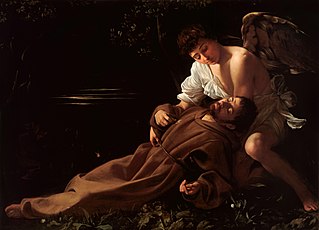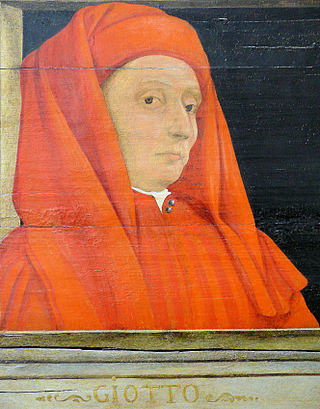Related Research Articles

Giovanni di Pietro di Bernardone, OFM, better known as Francis of Assisi, was an Italian mystic and Catholic friar who founded the Franciscans. He was inspired to lead a life of poverty as an itinerant preacher. One of the most venerated figures in Christianity, Francis was canonized by Pope Gregory IX on 16 July 1228. He is usually depicted in a brown habit with a rope as a belt, symbolizing the three Franciscan vows of poverty, chastity, and obedience.

The Franciscans are a group of related mendicant Christian religious orders within the Catholic Church. Founded in 1209 by the Italian saint Francis of Assisi, these orders include three independent orders for men, orders for nuns such as the Order of Saint Clare, and the Third Order of Saint Francis open to male and female members. They adhere to the teachings and spiritual disciplines of the founder and of his main associates and followers, such as Saint Clare of Assisi, Saint Anthony of Padua, and Saint Elizabeth of Hungary. Several smaller Protestant Franciscan orders exist as well, notably in the Anglican and Lutheran traditions.
Assisi is a town and comune of Italy in the Province of Perugia in the Umbria region, on the western flank of Monte Subasio.

Pietro Lorenzetti or Pietro Laurati was an Italian painter, active between c. 1306 and 1345. Together with his younger brother Ambrogio, he introduced naturalism into Sienese art. In their artistry and experiments with three-dimensional and spatial arrangements, the brothers foreshadowed the art of the Renaissance.
The anonymous text that is usually called the Prayer of Saint Francis is a widely known Christian prayer for peace. Often associated with the Italian Saint Francis of Assisi, but entirely absent from his writings, the prayer in its present form has not been traced back further than 1912. Its first known occurrence was in French, in a small spiritual magazine called La Clochette, published by a Catholic organization in Paris named La Ligue de la Sainte-Messe. The author's name was not given, although it may have been the founder of La Ligue, Father Esther Bouquerel. The prayer was heavily publicized during both World War I and World War II. It has been frequently set to music by notable songwriters and quoted by prominent leaders, and its broadly inclusive language has found appeal with diverse faiths encouraging service to others.

The Basilica of Saint Francis of Assisi is the mother church of the Roman Catholic Order of Friars Minor Conventual in Assisi, a town in the Umbria region in central Italy, where Saint Francis was born and died. It is a Papal minor basilica and one of the most important places of Christian pilgrimage in Italy. With its accompanying friary, Sacro Convento, the basilica is a distinctive landmark to those approaching Assisi. It has been a UNESCO World Heritage Site since 2000.

Giunta Pisano was an Italian painter. He is the earliest Italian painter whose name is found inscribed on an extant work. He is best known for his crucifixes.

Saint Francis of Assisi in Ecstasy is a painting by the Italian Baroque master Michelangelo Merisi da Caravaggio. It is now in the Wadsworth Atheneum, Hartford, Connecticut.

The Little Flowers of St. Francis is a florilegium, divided into 53 short chapters, on the life of Saint Francis of Assisi that was composed at the end of the 14th century. The anonymous Italian text, almost certainly by a Tuscan author, is a version of the Latin Actus beati Francisci et sociorum eius, of which the earliest extant manuscript is one of 1390 AD. Luke Wadding ascribes the text to Father Ugolino da Santa Maria, whose name occurs three times in the Actus. Most scholars are now agreed that the author was Ugolino Brunforte.

The Master of the Treasury was an Italian painter working in the Italo-Byzantine style during the middle of the thirteenth century. A follower of Giunta Pisano, he is known from a painting in the treasury of the Basilica of San Francesco d'Assisi representing the titular saint and four of his posthumous miracles.

The Master of the Blue Crucifixes was an Italian artist active either in the region of Umbria or Emilia during the middle of the thirteenth century. He is associated with the Basilica of San Francesco d'Assisi, and may have been an assistant of Giunta Pisano, whose work his paintings resemble. A number of his works survive, mainly processional crucifixes, from which his name is derived.

The Master of the Gubbio Cross was the name given to an Umbrian painter active between about 1285 and about 1320. He appears to have been familiar with the artists working at the Basilica of San Francesco d'Assisi, and some of his work bears a resemblance to that of Giunta Pisano.
The Expressionist Master of Santa Chiara was an Umbrian painter active between about 1290 and around 1330. He has been identified as one of Giotto's principal followers; some contend that his hand may be identified in a series of frescos attributed to Giotto in the Basilica of San Francesco d'Assisi. Among the surviving works attributed to him are a set of processional crucifixes, including one in the Cleveland Museum of Art.

The Master of the Sterbini Diptych was an Italian painter active most likely in Venice during the early fourteenth century; other locations along the Adriatic coast have also been suggested. Several panels associated with this artist are believed to exist; his name is derived from a painting now in the Museo del Palazzo Venezia in Rome. Little is known about the artist, save that he works in the Italo-Byzantine style, influenced by the Cretan school or Greek traditions of icon-painting. Some historians believe that the artist may actually be a workshop group.

The Master of San Martino alla Palma was a Florentine painter active during the first third of the fourteenth century. An immediate follower of Bernardo Daddi, he is named for an altarpiece in the parish church of San Martino alla Palma located within the town limits of Scandicci, in the province of Florence. His chronology is uncertain; he has been linked with the Master of Saint Cecilia, the Master of the Saint George Codex, and Lippo di Benivieni, among others.
The Master of the Assisi Choirbooks was an Italian manuscript illuminator active during the last quarter of the thirteenth century. Umbrian or Roman in origin, he is associated with work done for the Basilica of San Francesco d'Assisi; he seems to have known Cimabue's work for that church, and his work also indicates the influence of both the Master of the San Lorenzo Choirbooks and the Master of the Deruta-Salerno Missals.

Clare of Assisi was an Italian saint and one of the first followers of Francis of Assisi. Inspired by the teachings of St. Francis, she founded the Order of Poor Ladies, a monastic religious order for women in the Franciscan tradition. The Order of Poor Ladies was different from any other order or convent because it followed a rule of strict poverty. Clare wrote their Rule of Life, the first set of monastic guidelines known to have been written by a woman. Following her death, the order she founded was renamed in her honor as the Order of Saint Clare, commonly referred to today as the Poor Clares. Her feast day is on 11 August.

Giotto di Bondone, known mononymously as Giotto and Latinised as Giottus, was an Italian painter and architect from Florence during the Late Middle Ages. He worked during the Gothic and Proto-Renaissance period. Giotto's contemporary, the banker and chronicler Giovanni Villani, wrote that Giotto was "the most sovereign master of painting in his time, who drew all his figures and their postures according to nature" and of his publicly recognized "talent and excellence". Giorgio Vasari described Giotto as making a decisive break from the prevalent Byzantine style and as initiating "the great art of painting as we know it today, introducing the technique of drawing accurately from life, which had been neglected for more than two hundred years".
The Master of the Franciscan Crucifixes is the notname given to an Italian painter active in the 1260s and 1270s. The notname is based on a painted crucifix now in the Basilica of San Francesco d'Assisi, which was found to be connected stylistically with two painted crucifixes in Bologna and fragments of two paintings in the National Gallery of Art in Washington, D.C. The artist is presumed to have been Umbrian by origin and training.

Mauro Gambetti OFMConv is an Italian prelate of the Catholic Church who was appointed archpriest of Saint Peter's Basilica, Vicar General for the Vatican State, and president of the Fabric of Saint Peter on 20 February 2021. He was consecrated a bishop on 22 November 2020 just before Pope Francis raised him to the rank of cardinal on 28 November 2020.
References
- Morello, Giovanni and Laurence B. Kanter, ed.: The Treasury of Saint Francis of Assisi. Milan; Electa, 1999.